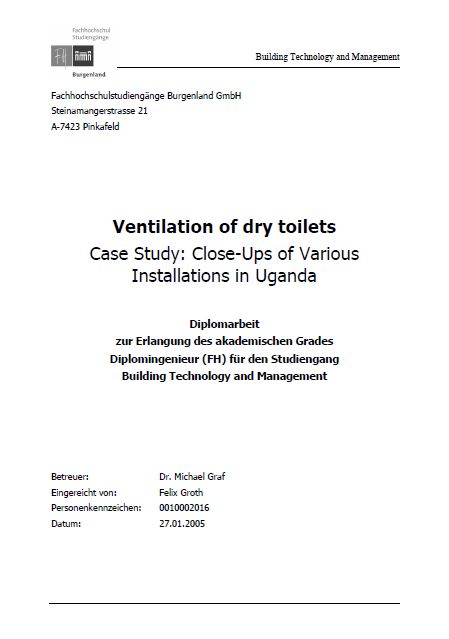Ventilation of dry toilets - Case Study: Close-ups of various installations in Uganda
Groth, F. (2005)

Published in: 2005
Publisher:
MSc Thesis. Burgenland University GmbH, Building Technology and Management, Pinkafeld, Germany
Author:
Groth, F.
Uploaded by:
SuSanA secretariat
Partner profile:
common upload
6010 Views
79 Downloads
Location of library entry
Content - Summary
Uganda is still one of the poorest countries in the world and is faced with an
abundance of economic, social and environmental problems. Even the will and the
motivation for development are remarkable and lead to significant success.
Dry toilet facilities are an appropriate solution to the sanitation problem, since they
improve sanitation provision where required, reduce respectively inhibit water
pollution, encourage water conservation and recover and recycle nutrients and
organic matter.
In order to support recent developments regarding alternative water and sanitation
concepts many research scientists work on different strategies, aiming new concepts
for a self-sustaining and affordable sanitation systems which also meets the
acceptance of the users. One of these new methods of solutions is based on the
separation of urine and faeces and is indicated as dry toilet. This technology is part
of a closed loop system, where human excreta are handled as a resource and where
these excretions are stored and treated on site.
But the storage and treatment of human excretions on site also causes various
problems, such as an unfavourable distribution of contaminated air towards the user
area.
Therefore, the main focus of this work was on finding solutions with which it
should be possible to reduce respectively to eliminate the odour in the user-chamber
of the dry toilet and its surrounding area. Thus, various facilities in the south-western
part of Uganda, such as Kabale, Kisoro, Kalungu and Mbarara were visited and
observed over a period of three month, from the 12th of March to the 12th of June.
Series of measurements and close-ups of existing installations gave an over-view
about the quality and efficiency of the implemented ventilation schemes. The
observed toilets were categorized as “Type Kabale” and “Type Enviro-Loo”, whereas
the ventilation technique of the first mentioned type can roughly be described as
simpler, cheaper and less advanced in comparison with the aeration technique of the
Enviro-Loo toilet.
Due to the quantification of recorded data and interviews, it was possible to find
specific solutions with the aim of finding new components and the adaptation of
already existing parts, regarding facility design and technical applications as follows:
Technical applications:
• Flow accelerator (with/without power supply)
• Shaped pieces/capture elements
• Vent pipe cover
• Squatting-pan lid (standard, mechanical, electrical)
Facility design:
73 Building Technology and Management
• Storage above the ground
• Consideration of the exhaust air direction
• Situation of the toilet according to the main wind/sun appearance
• Vent pipe diameter
With these measures and deliberations it should be possible to improve future dry
toilet implementations in view of aeration techniques and related design purviews,
whereas it has to mentioned that only the observation of practical implemented
constructions allow statements about their functionality and feasibility.
However, the further development of the dry toilet in view of aeration-technologies
and other purviews with the consideration of social, financial and technical parameter
is highly important to create a product, which is able to meet the requirements of
modern conventional sanitation facilities in order to be an accepted alternative option
to them.
Bibliographic information
Groth, F. (2005). Ventilation of dry toilets - Case Study: Close-ups of various installations in Uganda. MSc Thesis. Burgenland University GmbH, Building Technology and Management, Pinkafeld, Germany
Filter tags
Case studies in other formats English Sub-Saharan Africa Urine diversion dehydration toilets (UDDTs)














